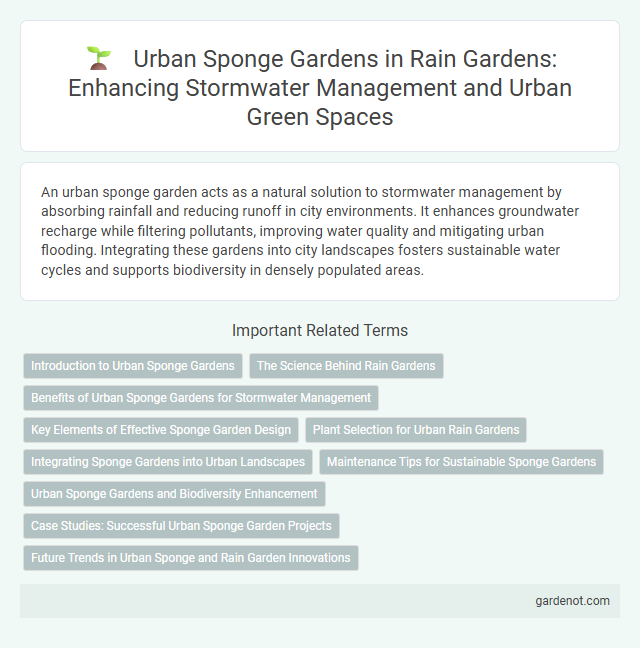An urban sponge garden acts as a natural solution to stormwater management by absorbing rainfall and reducing runoff in city environments. It enhances groundwater recharge while filtering pollutants, improving water quality and mitigating urban flooding. Integrating these gardens into city landscapes fosters sustainable water cycles and supports biodiversity in densely populated areas.
Introduction to Urban Sponge Gardens
Urban sponge gardens are innovative green infrastructure designed to manage stormwater by absorbing and filtering rainwater in densely populated areas. These gardens utilize permeable soil, native plants, and strategic landscaping to reduce runoff, improve water quality, and mitigate urban flooding. Incorporating urban sponge gardens contributes to sustainable city planning by enhancing groundwater recharge and supporting biodiversity.
The Science Behind Rain Gardens
Rain gardens function as urban sponge gardens by utilizing soil layers that mimic natural infiltration processes, capturing and filtering stormwater runoff to reduce urban flooding and groundwater contamination. Key scientific principles include soil permeability, plant root absorption, and microbial activity, which together enhance water retention and pollutant breakdown. Studies show that rain gardens can decrease surface runoff by up to 90%, improving urban water management and ecosystem health.
Benefits of Urban Sponge Gardens for Stormwater Management
Urban sponge gardens significantly reduce stormwater runoff by enhancing soil infiltration and capturing rainwater, which alleviates pressure on urban drainage systems. These gardens filter pollutants and sediments, improving water quality before it reaches natural waterways. By mitigating flooding risks and promoting groundwater recharge, urban sponge gardens contribute to sustainable urban water management.
Key Elements of Effective Sponge Garden Design
Urban sponge gardens rely on permeable soil, native plants, and efficient drainage systems to maximize water absorption and reduce runoff. Incorporating layers of sand, compost, and mulch enhances soil structure and supports plant health while facilitating natural filtration. Strategic placement near impervious surfaces and integration with rainwater harvesting ensures optimal stormwater management and urban cooling benefits.
Plant Selection for Urban Rain Gardens
Selecting native, deep-rooted plants such as sedges, rushes, and wildflowers enhances water absorption and pollutant filtration in urban sponge gardens. Plant species like Carex spp., Juncus effusus, and Echinacea purpurea are ideal for managing stormwater runoff due to their tolerance to both wet and dry conditions. Incorporating diverse vegetation with varying root depths maximizes soil infiltration and supports urban biodiversity.
Integrating Sponge Gardens into Urban Landscapes
Integrating urban sponge gardens into city landscapes enhances stormwater management by naturally absorbing and filtering rainwater, reducing runoff and mitigating flooding risks. These gardens use native plants and porous soil to create permeable surfaces that improve groundwater recharge and support urban biodiversity. Incorporating sponge gardens strategically in streetscapes, parks, and residential areas optimizes urban resilience against climate change impacts.
Maintenance Tips for Sustainable Sponge Gardens
Regular inspection of urban sponge gardens ensures optimal water absorption and pollutant filtration by identifying clogged soil or debris early. Incorporating native plants with deep root systems enhances soil permeability and reduces maintenance needs, promoting a resilient garden ecosystem. Seasonal pruning and mulching retain moisture, support plant health, and prevent erosion, contributing to the long-term sustainability of urban rain gardens.
Urban Sponge Gardens and Biodiversity Enhancement
Urban Sponge Gardens enhance biodiversity by capturing and filtering stormwater, reducing runoff while creating habitats for native plants and pollinators. These gardens improve urban ecological resilience by supporting diverse species and promoting soil health through natural water absorption and retention techniques. Integrating native vegetation in Urban Sponge Gardens strengthens local ecosystems and mitigates urban heat island effects.
Case Studies: Successful Urban Sponge Garden Projects
Urban sponge garden projects in cities like Singapore, Rotterdam, and New York have demonstrated effective stormwater management through permeable soil layers and native plant species. These case studies highlight significant reductions in urban flooding and improvements in water quality by capturing and filtering rainwater onsite. Implementing similar designs using local vegetation and smart water retention techniques can enhance urban resilience and biodiversity.
Future Trends in Urban Sponge and Rain Garden Innovations
Urban sponge gardens are evolving with smart irrigation systems that use IoT sensors to optimize water retention and reduce runoff in city landscapes. Advanced biofiltration materials are being integrated to enhance pollutant removal, improving water quality in urban watersheds. Future trends include modular, scalable designs that promote biodiversity while adapting to climate resilience challenges.
Urban sponge garden Infographic

 gardenot.com
gardenot.com